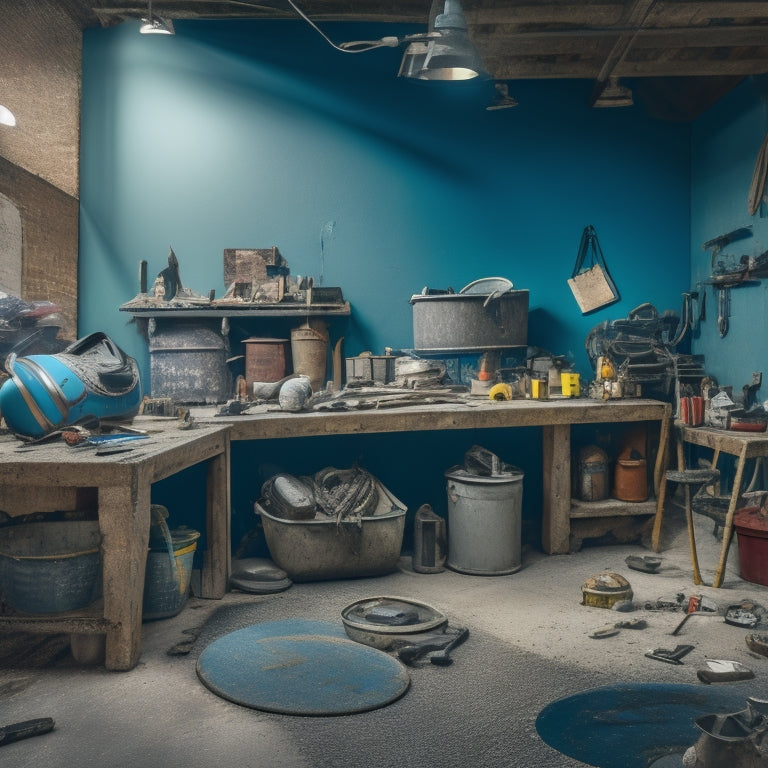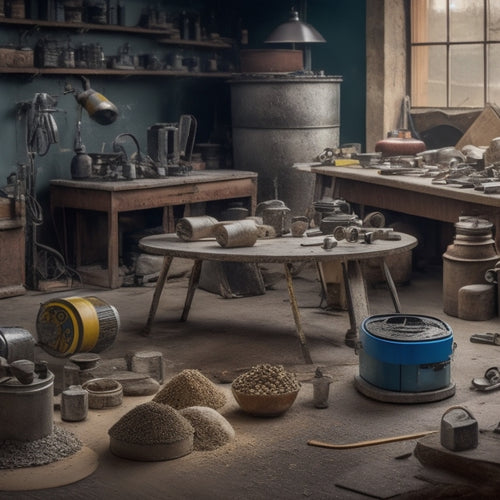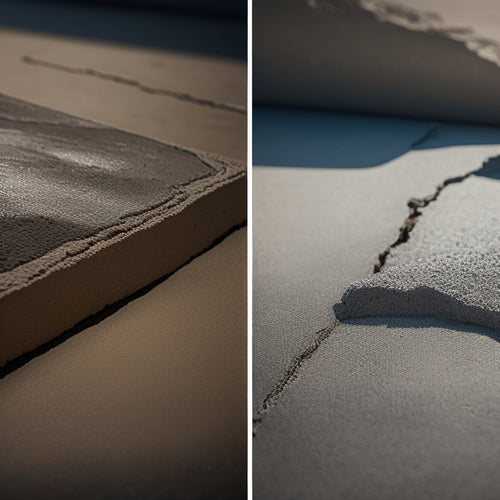
What Tools Do You Need for Concrete Flooring
Share
You'll need a thorough arsenal of specialized tools to achieve a high-quality, professional-looking concrete floor, including grinders, edgers, polishing pads, dust collection systems, safety gear, testing and measuring tools, and finishing and sealing equipment. From walk-behind grinders to handheld edgers, and from coarse to fine polishing pads, each tool plays a vital role in achieving a polished finish. Effective dust collection systems, safety gear, and testing tools are also necessary for a safe and successful project. To guarantee you're equipped for success, take a closer look at the specific tools and techniques required for a flawless concrete floor.
Key Takeaways
• Essential tools for concrete flooring include grinders, edgers, polishing pads, dust collection systems, and safety gear for a successful project.
• Grinders and edgers come in various types, such as walk-behind, handheld, and ride-on, to suit different project requirements and surface preparation needs.
• Polishing pads and accessories, like pad drivers and backer pads, are necessary for achieving a high-gloss finish and maintaining polishing efficiency.
• Dust collection systems, including centralized, portable, and HEPA filter systems, are crucial for maintaining a safe and healthy work environment by controlling dust.
• Safety gear, such as respirators, safety goggles, and protective clothing, is vital for protecting operators from hazards and health risks associated with concrete flooring projects.
Essential Grinders for Concrete
When preparing a concrete floor for finishing, you'll need to invest in a reliable grinder that can effectively remove imperfections, old coatings, and surface irregularities.
There are several grinder types to evaluate, each suited for specific tasks and floor conditions. For instance, walk-behind grinders are ideal for large areas, while handheld grinders are perfect for tight spaces and edges. You may also opt for a ride-on grinder for high-production grinding.
When selecting a grinder, you'll want to take into account reputable brands known for their durability and performance. Top grinder brands include Husqvarna, Metabo, and Bosch.
These brands offer a range of grinder models with varying features, such as horsepower, RPM, and dust collection systems. It's crucial to choose a grinder that matches your specific needs and floor requirements.
Additionally, consider the grinder's weight, maneuverability, and ergonomic design to guarantee operator comfort and safety.
Polishing Pads and Accessories
As you progress from grinding to polishing, you'll need a thorough arsenal of polishing pads and accessories to refine your concrete floor's surface, achieving the desired level of shine and reflectivity.
Polishing pads come in various materials, each suited for specific polishing techniques and stages. You'll require a range of pads, from coarse to fine, to gradually refine the surface. Metal-bonded pads, for instance, are ideal for aggressive cutting and removal of imperfections, while resin-bonded pads are better suited for finer polishing and honing. Hybrid pads, which combine metal and resin bonds, offer a balance between aggressive cutting and fine polishing.
Additionally, you'll need accessories like pad drivers, backer pads, and pad retainers to guarantee efficient and effective polishing. Pad drivers, for example, help to distribute pressure evenly across the pad, preventing uneven wear and improving results. Backer pads provide support and stability, allowing you to apply consistent pressure during polishing.
Best Dust Collection Systems
When you're working on a concrete flooring project, effective dust collection is essential to maintaining a safe and healthy work environment.
You'll want to take into account three key systems to achieve ideal dust control: centralized dust control, portable dust extractors, and HEPA filter systems.
Centralized Dust Control
You can greatly reduce airborne dust and improve workshop safety by integrating a centralized dust control system into your concrete flooring operations. This thorough approach to dust management techniques guarantees that dust is effectively captured and contained, preventing it from spreading throughout your workspace.
By installing a centralized system, you can create a cleaner and healthier work environment, which is essential for ideal air quality considerations.
A well-designed centralized dust control system typically consists of a network of ducts, hoods, and vents that connect to a central dust collector. This collector is usually a high-performance unit capable of capturing 99.97% of particles as small as 0.3 microns.
As you work on concrete flooring projects, the system continuously draws in dust-laden air, filters it, and releases clean air back into the workspace. This not only improves air quality but also reduces the risk of dust-related health issues and equipment damage.
Portable Dust Extractors
In addition to centralized systems, portable dust extractors offer a flexible and effective solution for capturing dust and debris at the source, providing a highly targeted approach to dust management on your concrete flooring projects.
These portable units are designed to be moved easily around the job site, allowing you to direct suction exactly where it's needed. One of the key portable extractor benefits is their ability to capture dust and debris at the point of generation, reducing the amount of airborne particles and preventing them from spreading throughout the work area.
When choosing dust extractors, consider factors such as airflow, suction power, and filter efficiency to guarantee you're getting the right tool for the job. Look for units with adjustable suction control, which allows you to tailor the airflow to the specific task at hand.
Additionally, consider the size and weight of the extractor, as well as its power source, to guarantee it can be easily maneuvered around the job site. By selecting the right portable dust extractor, you can effectively contain dust and debris, improving air quality and reducing the risk of respiratory hazards.
HEPA Filter Systems
High-Efficiency Particulate Air (HEPA) filter systems, widely regarded as the gold standard in dust collection, offer unparalleled performance in capturing 99.97% of particles as small as 0.3 microns, making them the best choice for concrete flooring projects that demand exceptional air quality and dust control.
When it comes to concrete flooring projects, you need a dust collection system that can keep up with the demands of grinding, polishing, and finishing. HEPA filter systems are designed to do just that, providing superior air quality and dust control. Their exceptional efficiency is due to the unique design of the filters, which are made up of a mat of randomly arranged fibers. This design allows them to capture even the smallest particles, guaranteeing that your workspace remains clean and safe.
To maintain the effectiveness of your HEPA filter system, regular maintenance is vital. You should clean or replace the filters as recommended by the manufacturer to secure peak performance. By doing so, you'll be able to maintain the high efficiency of your HEPA filter system, keeping your workspace clean and safe throughout the project.
With proper maintenance, your HEPA filter system will provide you with years of reliable service, making it an investment worth considering for your concrete flooring projects.
Concrete Floor Edgers Needed
Concrete floor edgers prove essential for creating a clean, defined edge along walls, obstructions, and other areas where the floor meets another surface. During concrete floor preparation, you'll need to remove any debris, dirt, or old adhesives that may interfere with the polishing process. Edge finishing techniques require specialized tools to achieve a professional-looking result.
When choosing a concrete floor edger, consider the following factors:
| Type | Application | Benefits |
|---|---|---|
| Walk-behind edger | Large areas, open spaces | Faster coverage, increased productivity |
| Handheld edger | Tight spaces, corners, and edges | Precision control, accessibility |
| Ride-on edger | Large, open areas, high-traffic zones | Increased efficiency, reduced fatigue |
| Electric edger | Indoor projects, noise-sensitive areas | Quiet operation, environmentally friendly |
| Pneumatic edger | Heavy-duty applications, high-torque needs | High power, reliable performance |
When selecting the right edger for your project, think about the size of the area, the type of surface, and the level of precision required. By investing in the right concrete floor edger, you'll achieve a smooth, polished finish that complements your overall concrete flooring project.
Safety Gear for Polishing
You'll need to protect yourself from the hazards associated with concrete floor polishing, including dust inhalation, eye damage, and skin irritation, by wearing the right safety gear. This isn't a step to be taken lightly, as neglecting safety protocols can lead to serious health issues.
To guarantee you're adequately protected, make sure you have the following essential items:
-
Protective eyewear: goggles or safety glasses with anti-fog coating to prevent eye damage from flying debris and dust
-
Dust mask or respirator: to prevent inhalation of harmful dust particles
-
Gloves: heavy-duty, dust-resistant gloves to protect your skin from irritation and abrasion
- Steel-toed boots: to protect your feet from heavy equipment and falling objects
Testing and Measuring Tools
By the time you're ready to begin polishing, it's vital that you've gathered the necessary testing and measuring tools to guarantee a successful outcome. These tools will help you assess the concrete's condition, identify potential issues, and secure a smooth polishing process.
You'll need a laser level to check the floor's flatness and detect any unevenness. This is especially important for large areas where minor deviations can lead to considerable problems. With a laser level, you can take precise readings and make adjustments as needed.
Moisture meters are another essential tool for concrete flooring. They help you measure the moisture levels in the concrete, which is critical for applying the right finishing products. If the concrete is too moist, it can lead to adhesion issues or other problems. By using a moisture meter, you can determine the ideal time for applying finishes and secure a strong bond.
Additionally, you may also need other testing and measuring tools, such as pH meters, surface profile gauges, and densitometers. Each of these tools serves a specific purpose and can greatly impact the quality of your finished floor.
Finishing and Sealing Tools
As you move on to the finishing and sealing stage of your concrete flooring project, you'll need to guarantee you have the right tools to achieve a durable, high-gloss finish.
You'll be working with specialized equipment to seal concrete surfaces, protecting them from stains and damage, and polishing concrete floors to a high shine.
In the following sections, you'll learn about the essential tools and techniques for sealing and polishing concrete to achieve professional-grade results.
Sealing Concrete Surfaces
Sealing concrete surfaces requires a range of specialized tools to ascertain a durable, long-lasting finish that resists stains, wear, and environmental damage.
As you prepare to seal your concrete floor, you'll need to choose the right sealer type and application technique for your specific project. There are various sealer types, including acrylic, polyurethane, epoxy, and silane-based sealers, each with its own strengths and weaknesses.
When it comes to application techniques, you'll need the right tools to ascertain a smooth, even finish. Here are some essential tools you'll need:
-
Sprayers or rollers: For applying sealers evenly and efficiently
-
Lambswool applicators: For applying sealers to large areas or for creating a textured finish
-
Microfiber cloths: For applying sealers to small areas or for cleaning up spills
- Notched squeegees: For removing excess sealer and achieving a uniform finish
Polishing Concrete Floors
Polishing concrete floors to a high-gloss finish requires employing the right finishing and sealing tools to remove imperfections, refine the surface, and protect the concrete from wear and tear.
You'll need a range of polishing machines, such as planetary grinders and floor polishers, to achieve the desired level of shine. These machines use abrasive pads or diamonds to gradually refine the concrete surface, removing scratches and imperfections. Effective surface preparation is critical, so make sure to clean the floor thoroughly before polishing and fill any cracks or joints.
To achieve a high-gloss finish, you'll need to progress through a series of polishing techniques, starting with coarse abrasives and gradually moving to finer ones. This process can be time-consuming, but the results are well worth the effort.
In addition to polishing machines, you'll also need to apply a concrete sealer to protect the floor from stains and damage. With the right tools and techniques, you can achieve a stunning, high-gloss finish that will enhance the beauty of your concrete floor.
Frequently Asked Questions
Can I Polish Concrete Floors in Extreme Temperatures?
When polishing concrete floors, you'll need to contemplate temperature effects, as extreme conditions can impact the process. In high temps, you'll risk resin crystallization, while low temps slow down the polishing process, so plan accordingly to achieve ideal results.
How Do I Remove Old Coatings From Concrete Floors?
When removing old coatings from concrete floors, like in the case of a 10,000 sq. ft. warehouse renovation, you'll need to employ a thorough coating removal process as part of surface preparation, using techniques like shot blasting or grinding.
Are Concrete Floors Suitable for Homes With Pets?
You'll find concrete floors surprisingly pet-friendly, as they're resistant to scratches and stains, and easy to clean. Plus, they're durable and low-maintenance, making them a practical choice for homes with pets, offering numerous concrete flooring benefits.
Can I Use Concrete Flooring in Areas With High Moisture?
You can use concrete flooring in areas with high moisture if you properly install moisture barriers and apply waterproof coatings to prevent water infiltration and damage, ensuring a durable and long-lasting floor.
Do I Need to Test Concrete Floors Before Polishing?
Did you know that 80% of concrete floors are not properly prepared for polishing? You'll need to test your concrete floors before polishing, using methods like moisture testing and surface hardness testing, to guarantee proper surface preparation and a successful polish.
Conclusion
As you begin the odyssey of concrete flooring, remember that having the right tools is essential to achieving a polished, shining surface that rivals the marble floors of ancient Greece.
With the necessary grinders, polishing pads, dust collection systems, edgers, safety gear, testing tools, and finishing equipment, you'll be well-equipped to tackle any concrete flooring project and emerge victorious.
Your floor will become a symbol of your skill and craftsmanship.
Related Posts
-

Top DIY Concrete Grinding and Polishing Tools
When selecting DIY concrete grinding and polishing tools, you'll want to take into account a range of factors to guar...
-

What Tools Ensure Strong Concrete Adhesion at Home
You'll need the right tools to guarantee strong concrete adhesion at home. For surface preparation, use concrete surf...
-

Top Mixing Tools for DIY Concrete Block Laying
When it comes to DIY concrete block laying, the right mixing tools are vital for a strong and durable structure. You'...


